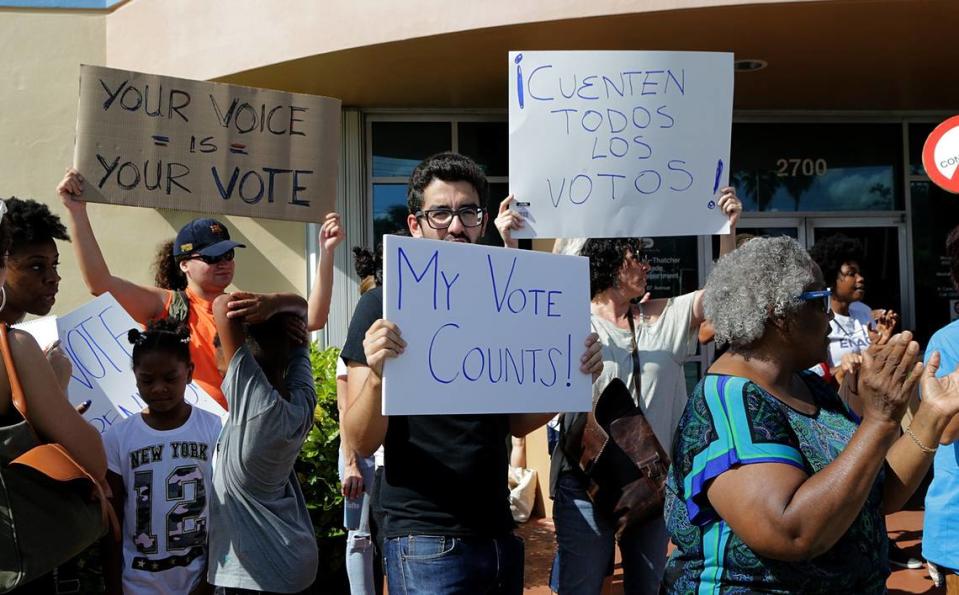Broward strikes deal with USPS to speed up process for record number of mail ballots
Planning for a record number of mail ballots amid concerns about whether the U.S. Postal Service can handle the load, Broward Elections Supervisor Peter Antonacci has come up with a way to streamline the process of getting Nov. 3 ballots to the elections office.
Under an agreement his office struck with the USPS, mail ballots that once had to pass through a massive distribution center in Opa-locka, in northwest Miami-Dade County, will now be picked up directly from local post offices by Broward elections workers starting the Saturday before Election Day.
And even before then, the deal with the USPS allows Broward elections workers to pick up mail ballots at a post office in Oakland Park, where ballots are being consolidated. On Tuesday, elections workers made their first pickup from the Oakland Park location, collecting about 14,000 ballots, according to Broward elections spokesman Steve Vancore.
Eliminating the stop at the Opa-locka facility means elections workers will have more time to notify voters if there is a problem — such as forgetting to sign the back of the ballot envelope — and fix the issue so the vote can be counted.
It also means more ballots may get to elections officials on time. In the August primary, more than 2,500 mail ballots in Broward County were rejected because they were received past the 7 p.m. Election Day deadline. In that election, Broward election workers went to the Opa-locka facility once the day before the election and twice on Election Day to retrieve mail ballots.
Under Florida law, elections offices must receive mail ballots by 7 p.m. on Election Day, regardless of when they were postmarked or arrived at a post office. (Exceptions are made for ballots sent from overseas.) Broward began shipping out more than 450,000 domestic mail ballots Sept. 24 — an enormous spike from the 291,000 requested in the county in the 2016 general election. Miami-Dade County will begin sending its domestic mail ballots Thursday, the last day of the window to do so.
“It ensures that more ballots will get counted that otherwise might not have been,” Vancore said of the Broward plan. The USPS, he added, was “extremely accommodating, extremely willing to help us.”
Broward’s effort to speed up the process comes not only in response to historic vote-by-mail numbers due to COVID-19, but also as officials try to avoid the vote-counting nightmares that have in the past struck South Florida.
In November 2018, the Opa-locka distribution center was the site of protests over concerns about uncounted ballots. And Broward County’s former elections supervisor, Brenda Snipes, was the target of outrage and false claims of fraud after over 2,000 ballots went missing, among other problems.
The Opa-locka distribution center is where Broward’s mail ballots are typically counted to determine how much the county owes the USPS in postage. Mail ballots don’t need to be postmarked, so the county covers the costs.
For the November election, Vancore said Broward initially offered to cover all of the costs up front — in other words, to pay the total cost of postage if every single voter who requested a mail ballot returned it. That ultimately wasn’t necessary, according to Vancore, because the USPS offered to count the ballots at its post offices instead of at the Opa-locka facility.
“USPS felt that generous offer was not necessary and they worked on a way to accommodate our requests without doing that,” Vancore said.
A USPS spokeswoman, Debra Fetterly, declined to discuss details of the arrangement.
“The U.S. Postal Service’s number one priority between now and the November election is the secure, on time delivery of the nation’s election mail,” Fetterly said in a statement. “We are working closely with local election officials in Broward County and across the country to meet that goal.”

A Miami-Dade elections spokeswoman said elections officials make daily trips to a post office near Miami International Airport to pick up the county’s mail ballots. On Election Day they make three trips, the last at 7 p.m.
The Opa-locka facility processes mail for some parts of Miami-Dade County, and ballots routed through Opa-locka are sent to the post office near the airport to be retrieved.
A history of problems
But back in 2018, on the Saturday after Election Day, Miami-Dade’s elections department received 266 stray ballots from the Opa-locka facility after photos posted on social media from inside the building showed dozens of mail-in ballots that hadn’t been delivered.
The photos sparked an outcry about uncounted votes. The postal service and the Miami-Dade elections department both said at the time that they had no indication any ballots had been mishandled, and that late-arriving ballots are typical after an election.

Broward County’s elections department also mismanaged the 2018 election and recount process. A county auditor said earlier this year that the process was so rife with problems that he couldn’t verify the accuracy of reported vote totals. Snipes, the elections supervisor at the time, was suspended and then retired. She was replaced by Antonacci, who was appointed by then-Gov. Rick Scott in December 2018.
A draft audit report said half the county’s polling places reported more votes than voters, and that mail ballots weren’t properly tracked, monitored or processed on time. Other issues noted in the audit included the poor design of the ballot and the misplacement of more than 2,000 ballots during the recount.

